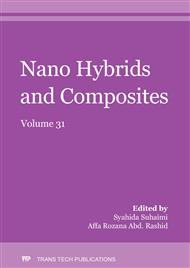[1]
Agharkar, M., Kochrekar, S., Hidouri, S., & Azeez, M. A. (2014). Trends in green reduction of graphene oxides , issues and challenges: A review. Elsevier Ltd, 59, 323–328.
DOI: 10.1016/j.materresbull.2014.07.051
Google Scholar
[2]
Hasan, M.T. (2018). Characterization And Modification Of Optical Properties. (August), 89.
Google Scholar
[3]
Jaafar, E., Kashif, M., Sahari, S.K., & Ngaini, Z. (2018). Study on Morphological , Optical and Electrical Properties of Graphene Oxide ( GO ) and Reduced Graphene Oxide ( rGO ). 917, 112–116.
DOI: 10.4028/www.scientific.net/msf.917.112
Google Scholar
[4]
AH Surani, ARA Rashid, N Arshad, AAN Hakim. 2019. High-Yield and Stepwise Synthesis of Graphene Oxide by Modified Hummers' Method. International Journal of Nanoelectronics & Materials 12 (4).
Google Scholar
[5]
Zaaba, N.I., Foo, K.L., Hashim, U., Tan, S.J., Liu, W.W., & Voon, C.H. (2017). Synthesis of Graphene Oxide using Modified Hummers Method: Solvent Influence. Procedia Engineering, 184, 469–477.
DOI: 10.1016/j.proeng.2017.04.118
Google Scholar
[6]
Shahhriary, L., & Athawale, A.A. (2014). Graphene Oxide Synthesized by using Modified Hummers Approach. International Journal of Renewable Energy and Environmental Engineering, 02(01), 58–63.
Google Scholar
[7]
Chua, C.K. & Pumera, M. (2013). Chemical reduction of graphene oxide: a synthetic chemistry viewpoint. Chem. Soc. Rev. 43, 291-312.
DOI: 10.1039/c3cs60303b
Google Scholar
[8]
Pei, S., & Cheng, H.M. (2012). The reduction of graphene oxide. Carbon, 50(9), 3210–3228. https://doi.org/10.1016/j.carbon.2011.11.010.
DOI: 10.1016/j.carbon.2011.11.010
Google Scholar
[9]
Stankovich, S., Dikin, D.A., Piner, R.D., Kohlhaas, K.A., Kleinhammes, A., Jia, Y., & Wu, Y. (2007). Synthesis of graphene-based nanosheets via chemical reduction of exfoliated graphite oxide. 45, 1558–1565.
DOI: 10.1016/j.carbon.2007.02.034
Google Scholar
[10]
Marcano, D.C., Kosynkin, D.V., Berlin, J.M., Sinitskii, A., Sun, Z., Slesarev, A.S., … Tour, J.M. (2018). Correction to Improved Synthesis of Graphene Oxide. ACS Nano, 12(2), 2078–(2078).
DOI: 10.1021/acsnano.8b00128
Google Scholar
[11]
Emiru, T.F., & Ayele, D.W. (2017). Controlled synthesis, characterization and reduction of graphene oxide: A convenient method for large scale production. Egyptian Journal of Basic and Applied Sciences, 4(1), 74–79.
DOI: 10.1016/j.ejbas.2016.11.002
Google Scholar
[12]
Kamisan, A.I., Kamisan, A.S., Md Ali, R., Tunku Kudin, T.I., Hassan, O.H., Abdul Halim, N., & Yahya, M.F. (2015). Synthesis of Graphene via Green Reduction of Graphene Oxide with Simple Sugars. Advanced Materials Research, 1107, 542–546.
DOI: 10.4028/www.scientific.net/amr.1107.542
Google Scholar
[13]
SuryaBhaskaram, D., Cheruku, R., & Govindaraj, G. (2014). Sugar assistedGraphene: A green synthesis approach. International Journal of ChemTech Research, 6(6 SPEC. ISS.), 3291–3293.
Google Scholar
[14]
Kamisan, A.I., Kamisan, A.S., Md Ali, R., Tunku Kudin, T.I., Hassan, O.H., Abdul Halim,N., & Yahya, M.F. (2015). Synthesis of Graphene via Green Reduction of Graphene Oxide with Simple Sugars. Advanced Materials Research, 1107, 542–546.
DOI: 10.4028/www.scientific.net/amr.1107.542
Google Scholar
[15]
Sharma, N., Sharma, V., Jain, Y., Kumari, M., Gupta, R., Sharma, S.K., & Sachdev, K. (2017). Synthesis and Characterization of Graphene Oxide ( GO ) and Reduced Graphene Oxide (rGO) for Gas Sensing Application. 1700006, 1–5.
DOI: 10.1002/masy.201700006
Google Scholar
[16]
Wang, S., Dong, Y., He, C., Gao, Y., Jia, N., Chen, Z., & Song, W. (2017). The role of sp 2 /sp 3 hybrid carbon regulation in the nonlinear optical properties of graphene oxide materials. RSC Advances, 7(84), 53643–53652.
DOI: 10.1039/c7ra10505c
Google Scholar
[17]
Chandu, B., Mosali, V.S.S., Mullamuri, B., & Bollikolla, H.B. (2017). A facile green reduction of graphene oxide using annona squamosa leaf extract. Carbon Letters, 21(1), 74–80.
DOI: 10.5714/cl.2017.21.074
Google Scholar
[18]
Velasco-Soto, M.A., Pérez-García, S.A., Alvarez-Quintana, J., Cao, Y., Nyborg, L., & Licea-Jiménez, L. (2015). Selective band gap manipulation of graphene oxide by its reduction with mild reagents. Carbon.
DOI: 10.1016/j.carbon.2015.06.013
Google Scholar
[19]
Zheng, F., Xu, W.L., Jin, H.D., Hao, X.T., & Ghiggino, K.P. (2015). Charge transfer from poly(3-hexylthiophene) to graphene oxide and reduced graphene oxide. RSC Advances, 5(109), 89515–89520.
DOI: 10.1039/c5ra18540h
Google Scholar


